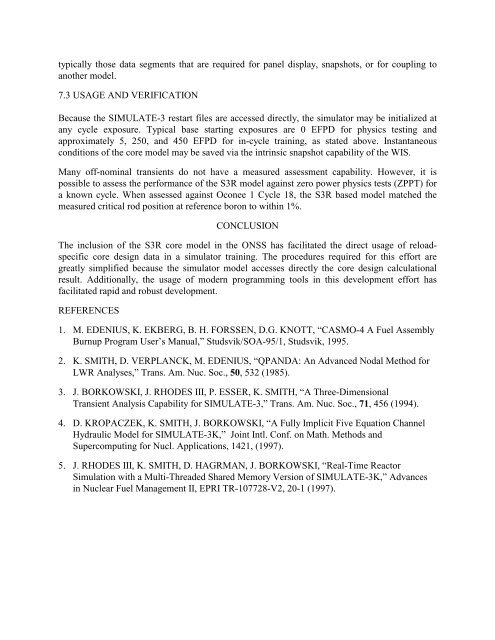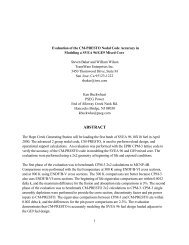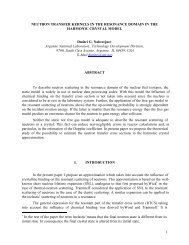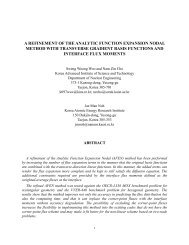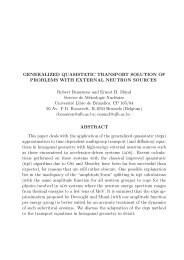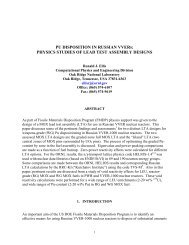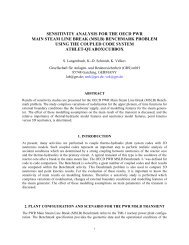J. Borkowski, K. Smith, D. Hagrman, and J. Rhodes, III
J. Borkowski, K. Smith, D. Hagrman, and J. Rhodes, III
J. Borkowski, K. Smith, D. Hagrman, and J. Rhodes, III
You also want an ePaper? Increase the reach of your titles
YUMPU automatically turns print PDFs into web optimized ePapers that Google loves.
typically those data segments that are required for panel display, snapshots, or for coupling to<br />
another model.<br />
7.3 USAGE AND VERIFICATION<br />
Because the SIMULATE-3 restart files are accessed directly, the simulator may be initialized at<br />
any cycle exposure. Typical base starting exposures are 0 EFPD for physics testing <strong>and</strong><br />
approximately 5, 250, <strong>and</strong> 450 EFPD for in-cycle training, as stated above. Instantaneous<br />
conditions of the core model may be saved via the intrinsic snapshot capability of the WIS.<br />
Many off-nominal transients do not have a measured assessment capability. However, it is<br />
possible to assess the performance of the S3R model against zero power physics tests (ZPPT) for<br />
a known cycle. When assessed against Oconee 1 Cycle 18, the S3R based model matched the<br />
measured critical rod position at reference boron to within 1%.<br />
CONCLUSION<br />
The inclusion of the S3R core model in the ONSS has facilitated the direct usage of reload-<br />
specific core design data in a simulator training. The procedures required for this effort are<br />
greatly simplified because the simulator model accesses directly the core design calculational<br />
result. Additionally, the usage of modern programming tools in this development effort has<br />
facilitated rapid <strong>and</strong> robust development.<br />
REFERENCES<br />
1. M. EDENIUS, K. EKBERG, B. H. FORSSEN, D.G. KNOTT, “CASMO-4 A Fuel Assembly<br />
Burnup Program User’s Manual,” Studsvik/SOA-95/1, Studsvik, 1995.<br />
2. K. SMITH, D. VERPLANCK, M. EDENIUS, “QPANDA: An Advanced Nodal Method for<br />
LWR Analyses,” Trans. Am. Nuc. Soc., 50, 532 (1985).<br />
3. J. BORKOWSKI, J. RHODES <strong>III</strong>, P. ESSER, K. SMITH, “A Three-Dimensional<br />
Transient Analysis Capability for SIMULATE-3,” Trans. Am. Nuc. Soc., 71, 456 (1994).<br />
4. D. KROPACZEK, K. SMITH, J. BORKOWSKI, “A Fully Implicit Five Equation Channel<br />
Hydraulic Model for SIMULATE-3K,” Joint Intl. Conf. on Math. Methods <strong>and</strong><br />
Supercomputing for Nucl. Applications, 1421, (1997).<br />
5. J. RHODES <strong>III</strong>, K. SMITH, D. HAGRMAN, J. BORKOWSKI, “Real-Time Reactor<br />
Simulation with a Multi-Threaded Shared Memory Version of SIMULATE-3K,” Advances<br />
in Nuclear Fuel Management II, EPRI TR-107728-V2, 20-1 (1997).


